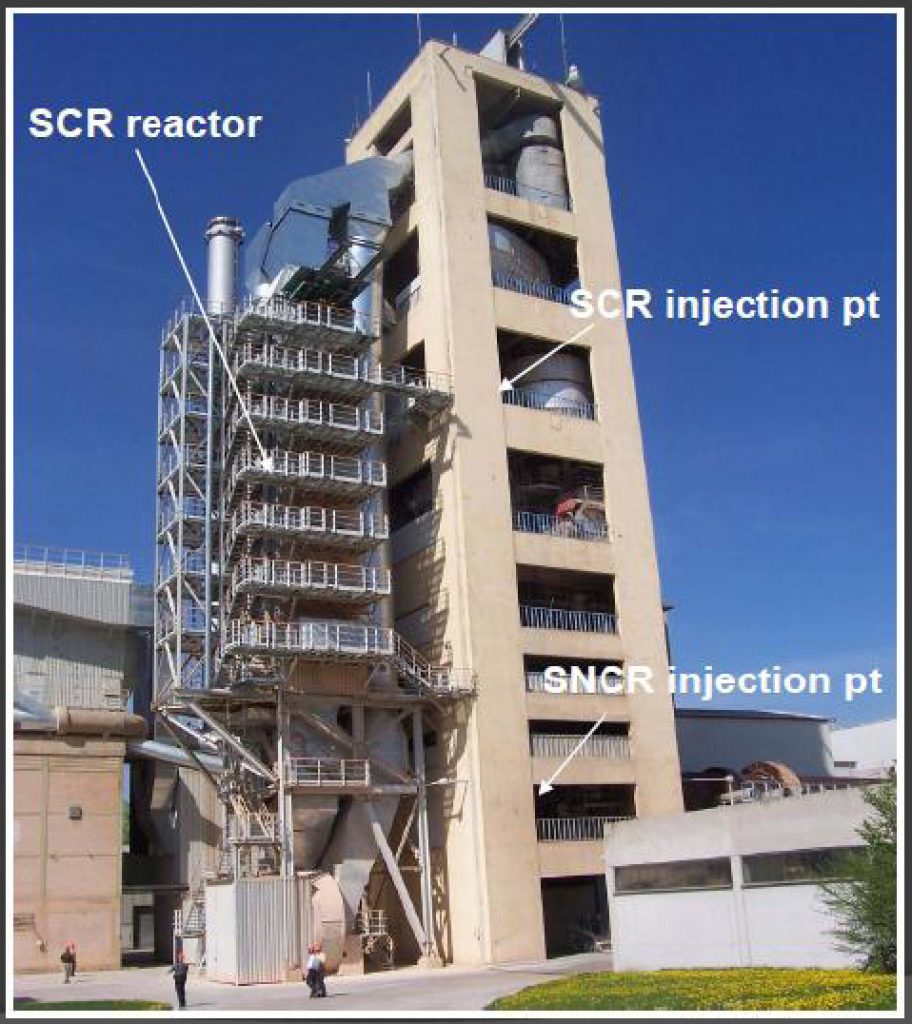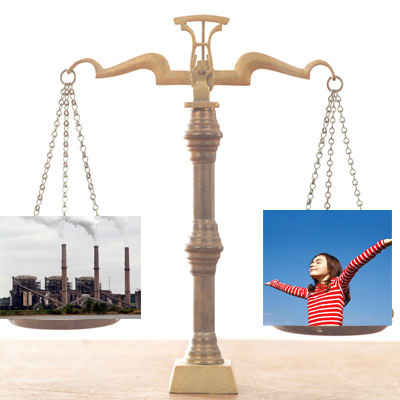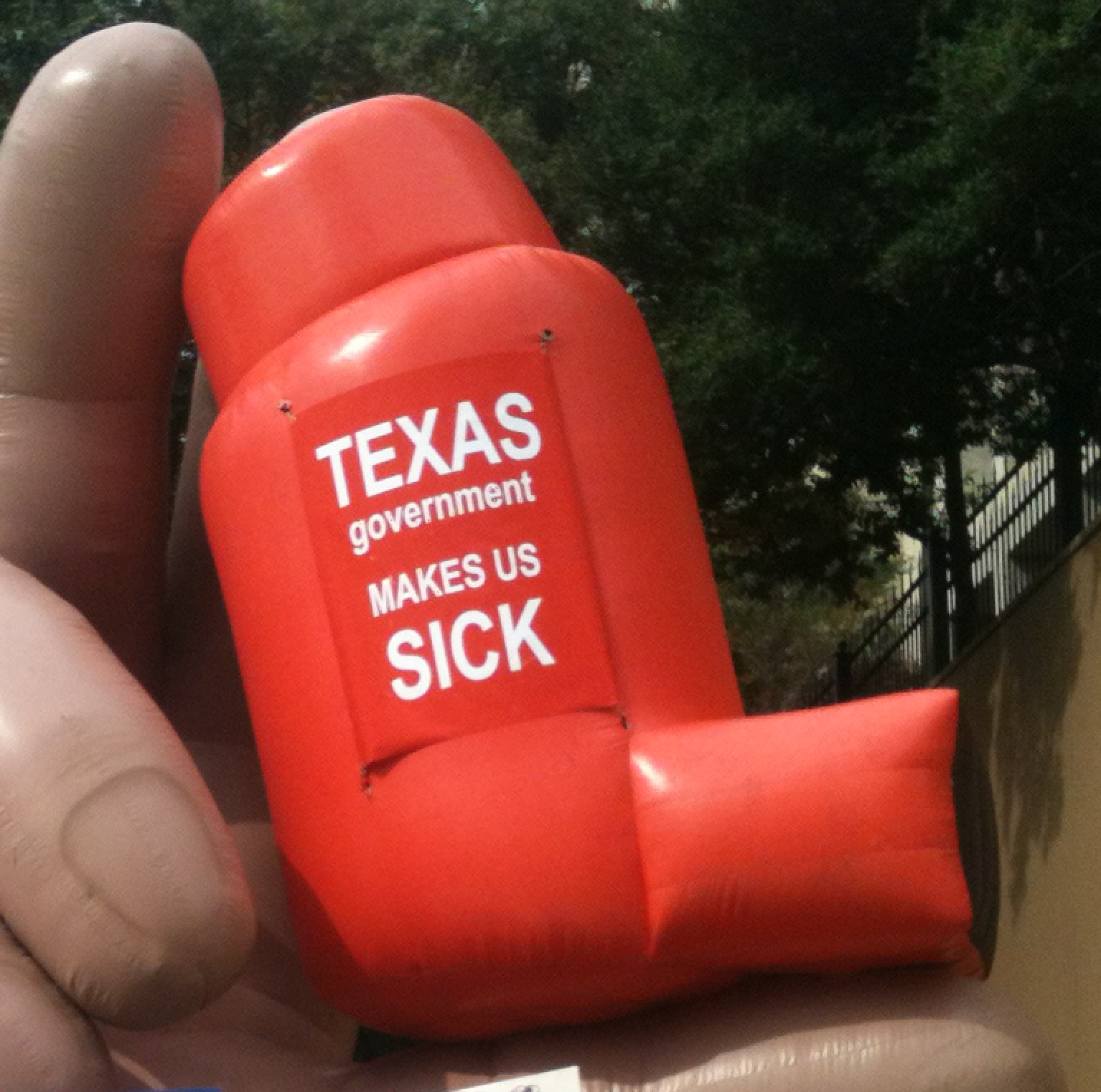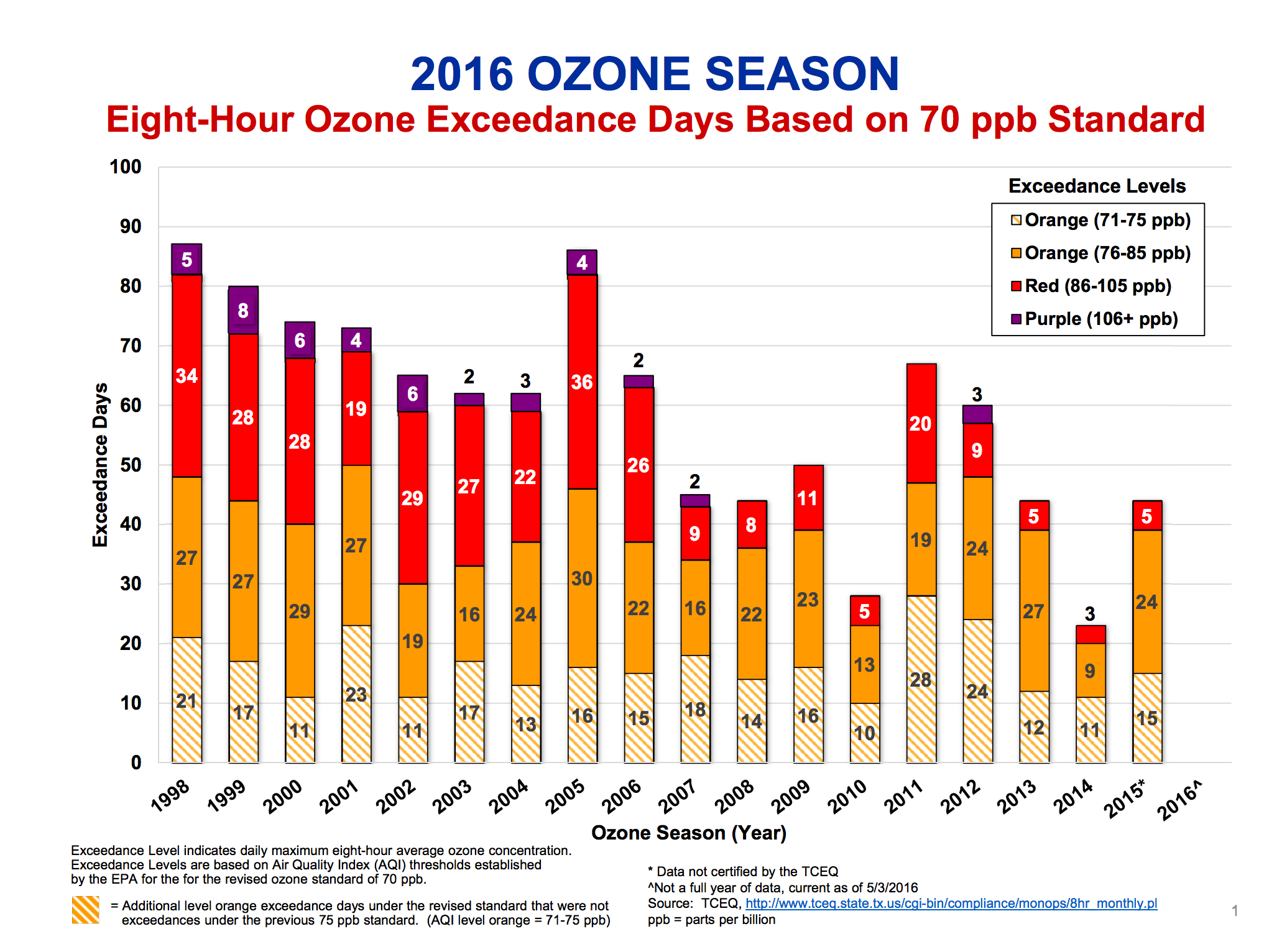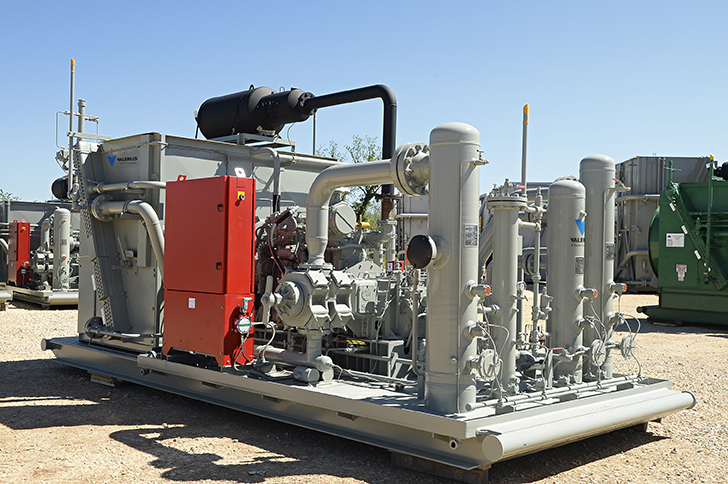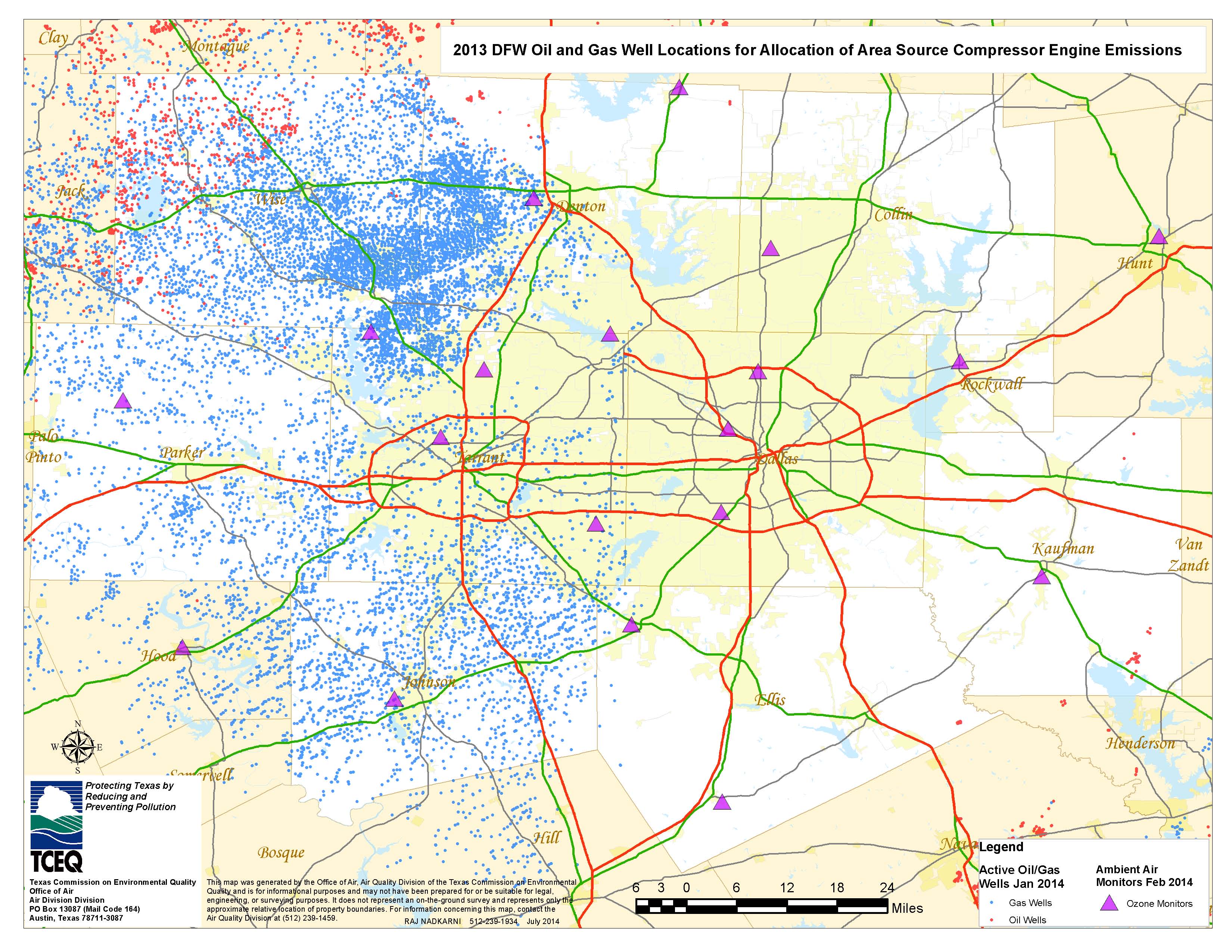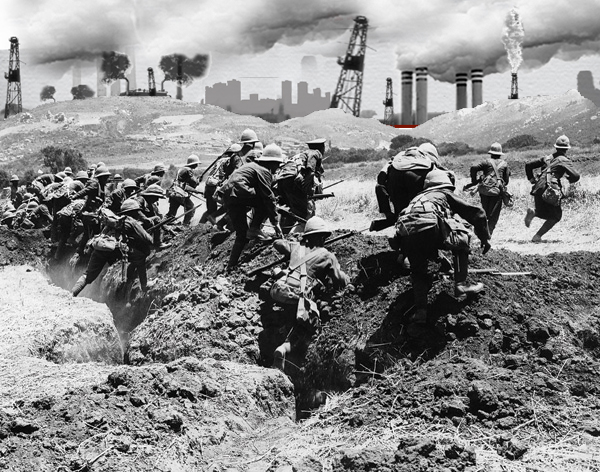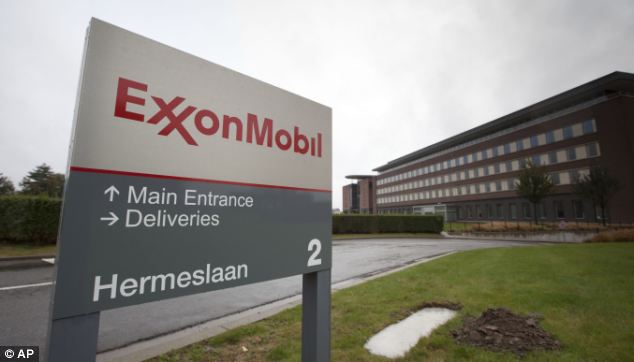Smog
We Did It: After 15-Years of Persistent Organizing, Citizens Finally See Modern Controls on a Midlothian Cement Plant. And Now We Want It on All of Them
 Holcim is the first cement plant in the nation to voluntarily install an industrial catalytic converter called SCR on its smokestack, significantly cutting smog-forming air pollution in DFW.
Holcim is the first cement plant in the nation to voluntarily install an industrial catalytic converter called SCR on its smokestack, significantly cutting smog-forming air pollution in DFW.
But despite operating only 26 miles from EPA headquarters, the Agency and State of Texas still claim the technology isn't "feasible"
Downwinders is proud to announce Midlothian's Holcim cement plant is the first in the nation to voluntarily install pollution control equipment significantly cutting smog-forming air pollution, along with other dangerous emissions.
"Not many people may notice, but Friday is a big day for air breathers in DFW, as well as for everyone in the country who lives downwind of a cement plant," said Tamera Bounds, Chair of Downwinders at Risk, the clean air group that's been relentless in its pursuit of the technology for North Texas since 2001.
Friday marks the official deadline for Holcim's Midlothian cement plant to have its Selective Catalytic Reduction, or SCR system, up and running on one of its two giant kilns in order to be compliant with EPA emissions limits.
Although almost a dozen cement plants in Europe have installed the technology over the last twenty years and it's widespread in the American coal industry, Holcim is so far the only cement plant in the U.S. to install SCR on one of its kilns without a government mandate.
A pilot test using SCR at Midwest cement plant was required by a Department of Justice enforcement action in 2010. Results show smog-forming pollution was cut by at least 80% – roughly twice as much as pollution controls now in use in the US, including Midlothian. In Europe, SCR has a track record of removing 80-90% or more of the smog-forming pollution that has kept DFW in violation of the Clean Air Act since 1991. It also cuts the emissions of air toxics, particulate matter, and dioxins by double-digits.
With three cement plants and four kilns, Midlothian hosts the largest concentration of cement manufacturing in the US, and the largest "stationary" sources of air pollution in DFW. Since the late 1980's, the city has become a national battleground over cement plant pollution. First, over the use of hazardous waste as "fuel" for the local kilns, then over the closing of dirtier, obsolete "wet" kilns contributing to smog and climate change, and now over how fast new kilns can be updated to reflect 21st technology. 
Bounds and others say the installation of SCR on all four kilns in Midlothian would mean a huge benefit to public health for residents in Tarrant County, where the predominant winds push the plumes from the kilns. A 2009 Cook Children's Hospital study showed childhood asthma levels highest directly downwind of the cement kilns.
The demand for the technology is a central part of the group's push to replace the current State-sponsored anti-smog plan with a more effective, and protective, one from EPA. So far, Dallas County, the City of Dallas, two Congressional Representatives and a State Legislator agree with them. But incredibly, the Agency maintains the SCR technology Holcim has freely invested in to reduce pollution and is already operating less than 30 miles from its regional headquarters is not "technically feasible."
Downwinders and other groups in the DFW Clean Air Network regional alliance are challenging EPA's refusal to recognize a game-changing pollution control technology that could help DFW finally put its smog problems behind it a well as offering similar help to other parts of the country downwind of cement plants.
"It's rare these days to find the EPA embracing Texas' approach to ignoring advances in environmental science, but that's exactly what happening," said Bounds. "Both State and EPA officials are acting like 3rd Graders – closing their eyes and humming loudly, pretending this time-tested technology isn't operating right in front of them. But it does, and it's here to stay."
Bounds wants the EPA to take note of the cuts in pollution triggered by Holcim's operation of its SCR system and then hold ALL the Midlothian plants to the same modern standard. "You have a piece of equipment that is setting a higher bar for pollution control. Every cement kiln in DFW should have to meet that higher bar now. No other anti-pollution strategy makes sense."
It's been a long and circuitous route to getting SCR installed in a Midlothian cement kiln. Along the way, the region's clean air activists moved the entire nation closer to widespread use of this control technology.
North Texans first heard about the use of SCR in the cement industry through a citizens group fighting a proposed new cement plant in New York state in 2001.They'd commissioned a study from a NYC engineering firm identifying European cement plants that had already successfully installed the technology.
Downwinders tried and failed to include SCR in the anti-smog plan in 2003. It then used a 2005 settlement agreement with the State over the failure of that plan to get the then Rick Perry-controlled Texas Commission on Environmental Quality to perform an independent assessment of the technology. That landmark study produced results that are still reverberating today. In it, five independent experts chosen by Downwinders, the cement industry, and the State declared SCR to be ready for prime time.
"SCR is a commercially available technology. It offers the possibility of significant NOx reduction at the plants in Ellis County. As an 'add on' technology, which can achieve 90% or greater NOx reduction, with demonstrated performance at hundreds of coal fired power plants, SCR is a viable technology that is available for both dry and wet kilns."
That conclusion, from cement industry experts, in a TCEQ study, is now a decade old.
At the same time they were working to bring SCR to Midlothian, Downwinders also led the fight for new EPA emission limits on cement kilns that burn hazardous waste. A 2009 national hearing at DFW Airport attracted over 200 people. Those emission limits clamped down on air toxics. Holcim couldn't meet them without adding controls. They choose an SCR unit on one kiln and a thermal oxidizer (re: flame) on the other to try and stay in compliance. Even though Holcim installed SCR to address air toxics, or Volatile Organic Compounds and not smog pollution, the effect on emissions will be the same.
Meanwhile, the 2006 TCEQ study and subsequent push by Downwinders for SCR in Midlothian helped persuade the EPA to require the pilot test in 2010. That test, as well as Holcim's experience in Europe, set the stage for SCR's official debut on the Texas prairie on Friday.
"It's been a long fight, but change is hard," said Bounds, "and it doesn't happen in a straight line."
Help Us Celebrate This Victory That Was 15 Years in the Making
Please consider contributing $25 or more on "GIVING DAY" NEXT THURSDAY to keep us on the front lines of change another 15 years.
Giving Day is an all day online giving event sponsored by the Communities Foundation of Texas.
Downwinders will have our own online Giving Day page where you can click and give from 6 am through 12 Midnight next Thursday.
Every contribution of $25 or more is matched or extended by the Foundation.
This year, we need your support to keep our full-time staff in the field, as well as fund our 2nd annual Root and Branch Revue for activists, and assemble our North Texas Clean Air Forceof air-monitoring drones.
Oh yeah, we're also opening a school for organizers in January.
We're based in DFW. All our board members are from DFW. Our priority is DFW air. Your contribution stays in North Texas to fund the fight for clean air in North Texas.
We know you're being assaulted by Giving Day appeals from all the local non-profits, and there are lots and lots of good causes. We only request that you ask yourself how many other local groups can repeatedly pull off meaningful victories with so few resources?
We were able to bring SCR to Midlothian with your help. We need your help again next Thursday. We think we've earned it.
Thanks.
Chris Turner Becomes First State Representative to Ask EPA for new DFW Air Plan
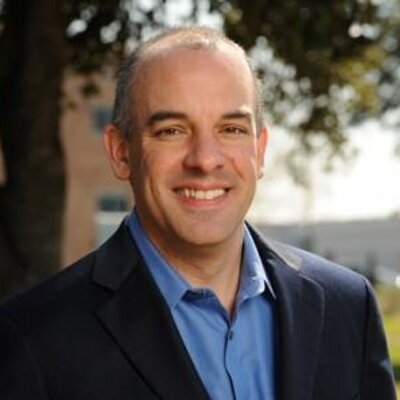 State Representative Chris Turner, whose District 101 spans west Grand Prairie and east Arlington between Dallas and Fort Worth became the first state elected official to urge EPA to reject the current state anti-smog plan for DFW and substitute one of its own.
State Representative Chris Turner, whose District 101 spans west Grand Prairie and east Arlington between Dallas and Fort Worth became the first state elected official to urge EPA to reject the current state anti-smog plan for DFW and substitute one of its own.
In a letter to EPA Chief Gina McCarthy, Turner used language echoing the sentiments of US Congresswoman Eddie Bernice Johnson and Congressman Marc Veasey.
"While I hope that the TCEQ will take the public comments it received by EPA, the Texas Medical Association, and others into consideration and require additional emissions controls in the final SIP revision it submits to EPA, I ask you to consider rejecting the state's plan use of a Federal Implementation Plan if your agency decides that the final SIP revision is insufficient and the state will not negotiate in good faith."
The entire letter can be read here.
Besides Johnson and Veasey's letters, Dallas County and the City of Dallas have voted in favor of resolutions condemning the currently proposed plan has being inadequate. More cities and counties are expected to pass similar resolutions as elected bodies come back from summer breaks.
Members of the DFW Clean Air Network (DFW CAN) – Downwinders at Risk, the Sierra Club, Beyond Coal, the Texas Campaign for the Environment, Mansfield Gas Well Awareness and Livable Arlington – are also out and about obtaining letters like Turner's from other state and federal elected officials.
Turner's district is directly downwind of the Midlothian cement plants and includes numerous natural gas wells and facilities. Gas sources are now the fourth largest contributor to DFW smog.
According to EPA, the state plan arrived at the EPA's doorstep August 8th, but it's already DOA.
Although ozone season is far from over and it's been a relatively mild "season" so far, we know in its second full year out of the three years allotted for success, the state air plan will, at best, have brought down ozone levels by 1 ppb from 2015 levels, to 80 ppb. We're supposed to be at 75.
The parrot is dead. We're just waiting for the state to admit it – or the EPA to shut the farce down.
Meanwhile, the more political support on the ground in DFW for an EPA alternative that might actually reduce emissions from major sources in North Texas like gas, cement kilns, and coal plants, the more likely it is for the Agency to accept the challenge, and endure all the pushback from Austin it'll get if it decides to take over the job.
If you're interested in trying to get your city, county, or state or federal elected officials to join the band wagon and reject the state plan, write or call us and we'll work with you in getting something accomplished that can add to the momentum.
We Already Know the State Air Plan for DFW has Failed a Second Year In a Row. The Only Question is By How Much.
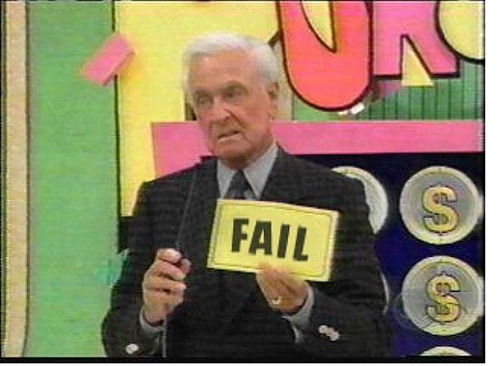 It's only July, but midway through its second year, we already know the state's air "plan" for DFW has once again failed to obtain compliance with the current 75 parts per billion ozone standard.
It's only July, but midway through its second year, we already know the state's air "plan" for DFW has once again failed to obtain compliance with the current 75 parts per billion ozone standard.
Last year the regional peak went from 80 to 81 ppb based on a rolling three-year average of readings from the Denton monitor. Even though we've only had one or two awful ozone weeks this year so far, those were enough to establish a 2016 Denton monitor average of 80 ppb going into what are tradtionally the smoggier months of August and September. So two years in, the state's plan can do no better than get us back to where we started in 2014 – and might do considerably worse.
Officially, the state's only hope for last-minute success is a drastic drop in smog at the Denton monitor next year in order to swing the three-year running average. Those hopes are hanging by a tailpipe with the scheduled introduction by the federal governement next summer of a new, lower-sulfur gasoline mixture for all U.S. cars and trucks. Austin's "plan," such as it is, is to ride the coattails of that change in gasoline formula in hopes its widespread use will significantly lower smog numbers thoughout DFW.
EPA agrees with Texas that they'll be a decline in vehicle-generated smog due to the new gas mix. However, it disagrees that it alone will be able to bring DFW into compliance with the Clean Air Act by the end of ozone season in 2017. At this point, the Denton monitor would have to have a 2017 fourth-highest reading of 64 ppb or lower to come in at a running average of 75 ppb. Not impossible, but it requires an unprecedented 10-11 ppb annual drop from the current average, much less the higher one that August or September might deliver.
The state can keep saying the clock is still ticking on their plan, but the numbers are already in, and they aren't cooperating.
This kind of math is the reason why Downwinders, the Sierra Club and other groups are requesting EPA to reject the state plan that now has arrived at its doorstep. It's the reason both Dallas County and the City of Dallas passed resolutions requesting the same, and the reason why both Congresswoman Eddie Bernice Johnson and Congressman Marc Veasey wrote a letter directly to EPA asking that the agency step in and do the job the state will not do.
Rejection of the bad state plan is the necessary first step in setting the stage for a more comprehensive EPA plan – one that would include all the large sources of smog pollution affecting DFW that have been untouched by state air plans over the last decade: like the oil and gas industry, the Midlothian cement kilns, and the East Texas coal plants.
We're tired of failure. We've experienced 25 years of it. We're experiencing it again this year. If you're tired of dirty air too, please contact us about how your city and county can pass a resolution asking the EPA to reject the state's plan and start writing one that will actually work.
Holy Gas Mask! Dallas City Council Finds Rare Unanimity, Votes 15-0 for Cleaner Air. Thank You
 Was it something in the air? Or maybe your emails in their mailboxes?
Was it something in the air? Or maybe your emails in their mailboxes?
Sandy Greyson, supported by a citizens army, pulled off the unthinkable and delivered a rousing 15-0 endorsement from the Dallas City Council for her resolution calling for a better smog clean-up plan for DFW than the one the state is currently pursuing.
Despite last-minute objections from coal plant operator Luminant and the Oil and Gas industry lobbying groups, Greyson wrangled the entire city council into agreeing the region can do better than a hands-off approach to major industrial polluters. Dallas County voted in support of a similar resolution in May.
It wasn't quite lions laying down with lambs, but it was close. She secured the votes of stalwart green council members Scott Griggs, Philip Kingston, and Adam Medrono, as well as council conservatives Jenifer Staubach-Gates, Lee Kleinman, Rickey Callahan, and Adam McGough. Southern Dallas members found common ground with their North Dallas peers. Trinity toll road opponents and supporters who don't even speak to each other all spoke in praise of Greyson and the resolution.
It wasn't just the final tally, as impressive an accomplishment as that is, that was shocking. It was all the different succinct points of view used to justify the resolution's passage. Philip Kingston berated the Texas Commission on Environmental Quality (TCEQ) for having morphed into an Orwellian institution, where "Freedom is Slavery, and Smog is Clean AIr." Lee Kleinman cited conservative economic principles to conclude "when a business takes clean air and makes it dirty, it should pay." Carolyn Arnold spoke to her disillusionment with the state over the Columbia meat-packing facility. Jenifer Staubach-Gates' decision was informed by her background as a school nurse.
As the last speaker before the historic vote, Mayor Mike Rawlings gave as good a summary of the tough position the current state strategy is putting local governments as you will hear. Dallas is stuck in the middle of "a game of chicken" between an inadequate plan from Austin and the requirements of the Clean Air Act. And the intent of the resolution is to put an end to that game and get serious about developing a practical cost-effective way to get clean air. It was the discussion's drop-the-mic moment.
There was also a marked diversity among citizens showing-up at City Hall to speak in favor of the resolution. Latino, black and white citizens joined ranks. Usual suspects Sierra Club, Texas Campaign for the Environment, and Downwinders at Risk, were joined by Mansfield Gas Well Awareness, as well new neighborhood group, West Dallas 1. Despite pre-vote visits and letters, no opponents of the resolution signed-up to speak.
If you ever doubted your emails to city council have an impact, this vote is proof-positive they do. Mayor Rawlings described the campaign leading up to the resolution's passage as a "textbook example" of how citizens and policymakers can craft progress on important issues, specifically calling out the hundreds of emails he and the rest of the council received, and the methodical process supporters pursued.
Thank you to everyone who took the time to send an email or make or call. You helped make this good thing happen. Everyone gets an "A" in Citizenship this month.
A win in the non-attainment area's largest city would have given the proponents of a new air plan confidence going into other North Texas communities in search of similar resolutions. A 15-0 vote from Dallas turbocharges that effort. This is a strong signal that local governments need to act, regardless of ideology, to protect their own self interests. It will be heard throughout the region by other Mayors and elected officials.
Where do we go next? Good question. Local officials are talking amongst themselves to decide where similar resolutions should be introduced next, but let us know if you're interested in helping us pass one in your city or county.
And, look, if you think this was a worthwhile thing, that we made some kind of progress today, then won't you please consider dropping $25 or more in the tip jar?
We win these victories with scant resources, that are, frankly, scantier these days. We want to keep rolling. Help us keep the wheels greased. DONATE HERE.
Thanks. Onward thru the smog.
Dallas City Hall Tomorrow: King Coal Capitulation or Clean Air Appreciation?
Rally in Support of Clean Air
Tomorrow- Wednesday, June 15
9:30 AM City Hall flag Room
5th floor at Dallas City Hall, 1500 Marilla
Speakers Include:
Lon Burnam, Former Texas State Representative
Ronnie Mestas, President of West Dallas One
Sonja Cooper and Adenike Higgins, asthma patients
Cherelle Blazer, Sierra Club Beyond Coal
If DFW is to have any chance of meeting federal smog standards before the end of this decade, it must have a better plan to clean the air than the one being currently proposed by the State of Texas.
To get that better plan, local governments must tell the state and EPA to go back to the drawing board and cut pollution from all major industrial sources, including the Midlothian cement kilns, huge natural gas compressors, and the East Texas coal plants. According to the state's own data and modeling, cutting pollution from these major source is a cost-effective strategy which can significantly lower smog levels in DFW.
On Wednesday the Dallas city council is voting on a resolution that tells the State of Texas and EPA we must do better than another 25 years of failure. It urges the state and federal government to get serious about cutting pollution from major sources. Reportedly, Luminant, (the old TXU), assisted by the Dallas Chamber of Commerce, is attempting to persuade the City Council to reject the clean air resolution based on its call for modern controls on the aging East Texas coal plants Luminant operates.
As of today, we don't have a reliable vote count. We must not take support for granted. Please join us tomorrow morning at City Hall to rally for clean air to breathe 365 days a year.
Sign up to speak to the council in favor of the clean air resolution by calling the City Secretary's office (214-670-3738) and telling them you want to speak for "Item 12" on the consent agenda. If you don't sign up before tomnorrow, you won't get to speak. Talking points are in this post.
This may be the most important clean air vote the City Council makes all year. It can create momentum for other cities to pass similar resolutions. It can send Austin and Washington a powerful message. But we need your help to make it happen.
We Have A Fight On Our Hands: Luminant Said To Be Trying to Scuttle Dallas Clean Air Resolution With Dallas Chamber Help
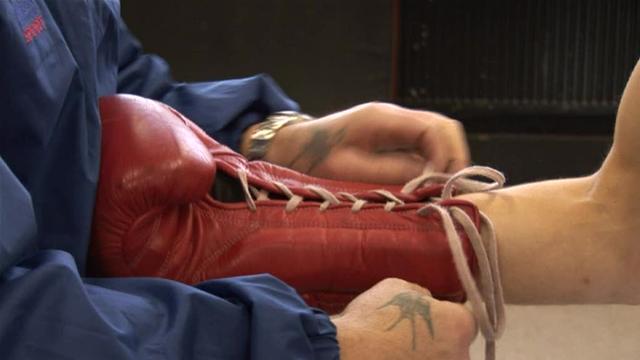 Only 48 hours after the single worst day for DFW smog since 2013, coal plant operator Luminant reportedly began a lobbying campaign to scuttle Sandy Greyson's Dallas city council clean air resolution requesting a better anti-smog plan.
Only 48 hours after the single worst day for DFW smog since 2013, coal plant operator Luminant reportedly began a lobbying campaign to scuttle Sandy Greyson's Dallas city council clean air resolution requesting a better anti-smog plan.
As a result, Item #12 “A resolution authorizing the City of Dallas to communicate its positions and requests regarding the Texas Commission on Environmental Quality's (TCEQ's) proposed State Implementation Plan for the Dallas-Fort Worth Region ozone pollution to the State of Texas, the TCEQ, and other agencies” is expected to be pulled from Wednesday’s unanimous voice-vote “consent agenda” and placed in line with other items generating discussion and dissent. It may be a long day – and that's exactly what the resolution opponents want in order to wear us down.
Luminant was said to be contacting city council members over the weekend, reportedly with the assistance of representatives of the Dallas Chamber of Commerce. In the past the company has stated it objects to the costs of installing the kind of modern anti-smog controls, referenced by the city’s resolution, at its three aging East Texas coal plants, despite their large smog-causing emissions. We don't know how successful the company's lobbying has been, or how much trouble the resolution is in.
If you're mad about this news, good. Here's what we need you to do:
1. If you haven't already, please follow this link and send a "click and send" ready-to-go email to all 15 Dallas city council members urging them to vote for the clean air resolution. You can add your own language at the bottom if you want.
2. Please sign up to speak in favor of clean air and the resolution on Wednesday
You must call the City Secretary''s office at 214-670-3738 to reserve a 3 minute speaking slot. Make sure you sign up for Item #12 on the consent agenda. If you don't sign-up in advance, you won't get to speak up on Wednesday!
We need to be there beginning at 9am, but we don't know how soon the resolution will come up in the agenda now. We know this makes it inconvenient. Again – not by accident. We've outlasted them before. We need to do it again.
3. Emphasize these Talking Points in your emails and speaking on Wednesday
-
All the air pollution control measures referenced in the city's clean air resolution are currently available, off-the-shelf technology, already in use in the world, US, and even Texas. Nothing exotic. Nothing experimental. There are coal plants and cement kilns with catalytic converters. There are already electric compressors. The resolution says only that the state should consider applying these technologies uniformly – to ALL major industrial sources affecting DFW air quality.
-
All the air pollution measures referenced in the city's clean air resolution are among the most cost-effective that can be taken, costing a small fraction of other measures already adopted. Putting controls on the coal plans and kilns costs $2-3,000 per ton of smog-forming pollution removed vs state programs spending $10-13,000 per ton. It's cheaper to prevent pollution at a dozen or so smokestacks than millions of tailipipes.
-
Most smaller Dallas businesses are already heavily-regulated for emissions because they're located within the DFW "non-attainment area," for smog, while the East Texas coal plants creating a huge chunk of that smog continue to be exempt from the same kind of regulations because they're located 90-100 miles outside the non-attainment area. They have more impact, but less regulation. That's not fair to Dallas-based businesses, or DFW''s seven million residents. We need small business owners to say the Chamber and Luminant doesn't speak for all of the Dallas business community.
-
The costs of installing new controls are small compared to the economic and public health costs of not installing them. Dr. Robert Haley's recent study for the Dallas County Medical Society concluded a drop of just 5 ppb in North Texas smog levels could save $650,000,000 in lost economic growth, and prevent hundreds of ER admissions, and 100 premature deaths – EVERY YEAR.
-
Luminant is taking the position that their three old coal plants are more important than the health of 1.2 million Dallas residents, and the other 5.5 million DFW citizens who breathe dirty air. The company is asking the Dallas City Council to place its interests above everyone else's.
-
DFW has been in continual violation of the Clean Air Act for smog since 1991. Our childhood asthma rates are higher than the state OR national average. EPA has already said the current plan doesn't do enough to lower smog levels to meet the federal standard. But opponents of the resolution have no alternative. They want the City of Dallas to sit on its hands and do nothing about 25 years of chronic smog – no matter how many people are affected by bad air. Does the City of Dallas really want to send the message that it doesn't care about clean air only a week before it hosts its own "Clean AIr Action Day" event at City Hall Plaza next Friday?
Some critics of these resolutions have argued they're only symbolic requests for cleaner air, and don't mean that much, or carry that much weight. If Luminant's reported response is any indication, it thinks this resolution is a threat to plans to sell-off those aging coal plants as part of its parent company's bankruptcy. We must be doing something right to engender this kind of alleged opposition from North Texas' King of Coal.
DON'T LET BIG COAL WIN THIS FIGHT
SPEAK UP IN SUPPORT OF CLEAN AIR – Call the City Secretary and Register to speak on Wednesday
THIS WEDNESDAY, JUNE 15th
9 AM DALLAS CITY HALL 1500 MARILLA
Summer Isn’t Coming, It’s Here. Ozone Season Arrives with a Vengeance.
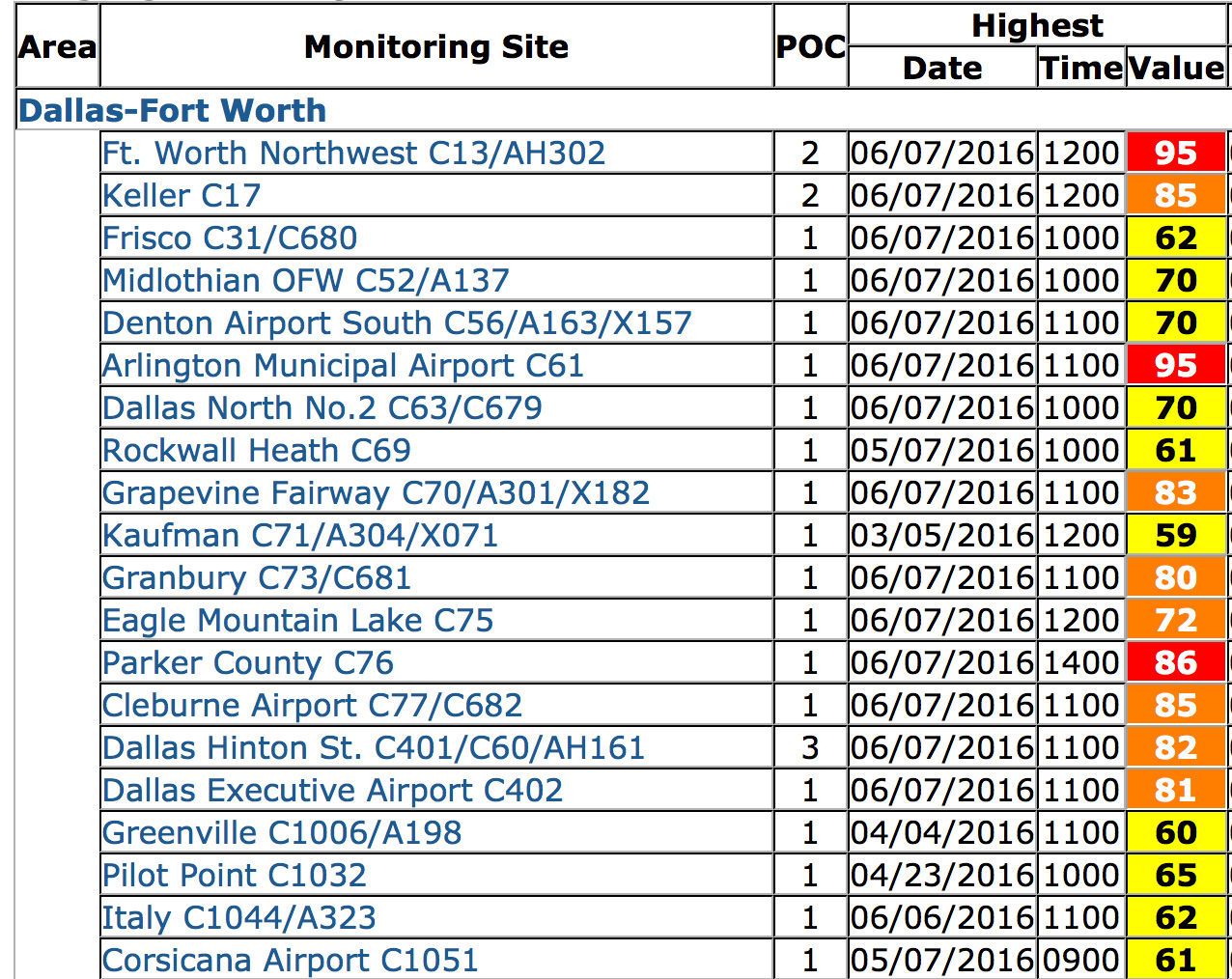 Yesterday was the single worst day for DFW smog in the last three years.
Yesterday was the single worst day for DFW smog in the last three years.
Seven monitoring sites stretching from central Dallas to Weatherford saw hourly averages of 90+ parts per billion. Three sites in Arlington, Northwest Fort Worth and Keller saw levels reach 100 + ppb. Two of those sites saw hourly levels climb to 113 ppb. To give you some idea of how bad that is, the original dreadful, obsolete standard during the 1980's and early 90's was 125 ppb in a single hour. We probably came within an hour or two of reaching a level of air pollution at not one, but two sites yesterday that would have exceeded a 40-year old smog standard.
14 out of the 20 DFW monitors recorded average ozone "exceedences" that violated the current 75 ppb 8-hour standard (what you see above). Two sites saw 8-hour averages of 95 ppb, the worst showing since September 2013.
It became a hazard to breathe for hundreds of thousands, maybe millions of DFW residents, yesterday afternoon. South Arlington residents experienced unhealthy levels of air pollution from 12 noon to 7 pm. In Keller it was 2 to 7 pm.
The good news? It could have been worse. The only thing preventing even higher numbers was the changing wind direction in mid-day. Monitors located in Dallas were recording high smog levels in the morning and lunchtime from northerly winds, but then they turned east and the pollution headed west, raising smog levels across broad swaths of Tarrant, Johnson, and Parker Counties. Had the wind been coming from the east all day, you would have seen the numbers those monitors reached at 2 -5 pm happen sooner, with more room to grow.
Wednesday also looks to be a bad day, as does the rest of the week of full-bore summer sunshine. Bad as they were, none of yesterday's exceedences actually count as a Clean Air Act violation…yet. It takes four bad days where the 8-hour average exceeds the 75 ppb standard over the course of the ozone season to make a violation. Regulators only use the fourth highest smog level recorded at each site to determine the annual average and whether an area is meeting the Clean Air Act standard (you can keep track of those here). Yesterday, nine monitors recorded their first exeedence of the year. Only three more to go.
However, the region's current reigning bad air champ, the Denton airport monitor, uncharacteristically remained out of harm's way and saw levels barely above the 75 ppb standard in mid-afternoon. It'll have it's chance. Summer is only beginning.
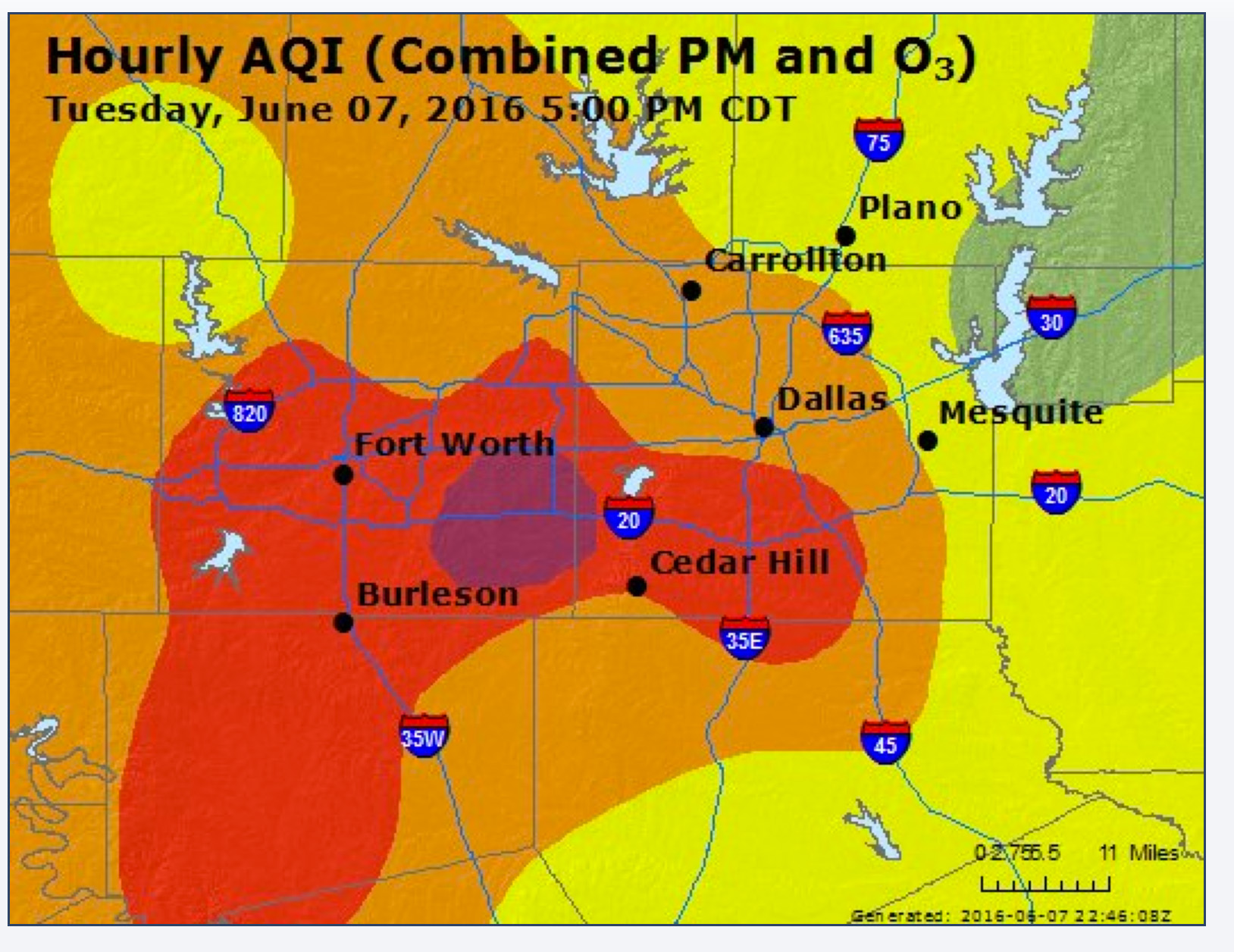 Tuesday's smog attack put an exclamation point in front of next Wednesday's Dallas City Council scheduled vote on Councilwoman Sandy Greyson's air quality resolution rejecting the current state plan – ain't it working out swell!? – in favor of a plan to eliminate days like yesterday.
Tuesday's smog attack put an exclamation point in front of next Wednesday's Dallas City Council scheduled vote on Councilwoman Sandy Greyson's air quality resolution rejecting the current state plan – ain't it working out swell!? – in favor of a plan to eliminate days like yesterday.
Greyson's resolution requesting a new and better clean air plan, as well as the staff presentation that provided background information, can be reviewed here. It's similar in content to one passed earlier in May by Dallas County.
Supporters can sign-up to speak for 3 minutes each when it comes up on the agenda and as always, we'll have plenty of lapel pins with the DFW Clean Air Network logo on them so you can non-verbally support the resolution as well.
If you want to speak at the Council meeting in favor of clean air, please contact the City Secretary beginning at 8:15 am tomorrow, Thursday, June 9th at (214) 670-3738 to reserve a 3-minute speaking slot or Item #12 on the "consent agenda."
Consent agendas are tricky things. They require complete unanimity among all 15 council members and are usually reserved for the most benign, non-controversial subjects. So at first glance, it's a good thing our resolution is on the list because it implies support from all 15 members.
But, and it's a big but….any member who doesn't agree it should be on the consent agenda can ask that it be taken off and placed in the "Items for Individual Consideration" bin – kind of like going to the back of the line and waiting for all the other business to get done before re-visiting the matter.
If there's industry opposition, or any opposition for that matter, it would give a council member an excuse to take it off the consent agenda and send it to the back of the line in hopes us cooling our heels and losing speakers as the day wears on. And it only takes one council member disagreeing to do so. This is why we need you to send emails to ALL 15 council members.
Since it's on the consent agenda, at least for now, it'll be among the first orders of business next Wednesday. Supporters need to show up at 9 am sharp.
Dallas passing this resolution would mean that the most populous city in the DFW "non-attainment area" for smog is rejecting the anti-science "do-nothing" approach of the State and demanding a better strategy to actually clean up chronic air pollution.
That's exactly the kind of statement local governments have to send EPA in order for the federal agency to screw-up enough courage and reject the current state proposal in favor of something better.
And after yesterday, is there anyone outside of Austin who believes we don't need something better?
Dallas City Council Clean Air Vote
Wed. June 15th 9am
Dallas City Hall 1500 Marilla
Dallas Council Committee Votes for Air Quality Resolution, Heads for Full Council Vote in June
SEND A "CLICK N SEND" EMAIL TO ALL 15 DALLAS CITY COUNCIL MEMBERS URGING THEM TO VOTE FOR CLEANER AIR IN JUNE
By a vote of 5 to 1 the City of Dallas moved closer to joining Dallas County in repudiating the State's do-nothing DFW clean air plan and demanding something better.
It was the second vote in less than a month to condemn an anti-smog strategy the Texas Commission on Environmental Quality claims gets DFW "close enough" to the current federal standard, but is criticized by clean air advocates as inadequate to end the region's chronic bad air problem.
In April U.S. Congressional Representatives Eddie Bernice Johnson and Marc Veasey asked the EPA to reject the State plan and write its own.
Council members Mark Clayton, Philip Kingston, Tiffini Young, and Rickey Callahan backed a wide-ranging air quality resolution sponsored by Quality of Life Committee Chair Sandy Greyson. Casting the lone no vote was Adam McGough.
Greyson's resolution cites the EPA's conclusion "that the latest air quality State Implementation Plan (SIP) proposed by the Texas Commission on Environmental Quality (TCEQ) is not adequate to address the (the region's) ozone concentrations"
One reason given for the inadequacy is the plan doesn't touch major sources of air pollution affecting DFW including the East Texas coal plants, the Midlothian cement kilns and oil and gas facilities. The resolution specifically requests the state to follow the prescription laid out by UNT's landmark 2015 DFW ozone study, itself based on the State's own computer air model by adding off-the shelf control technology to those industrial sources.
Besides rejecting the state's plan, the resolution also takes issue with the State's assertion that lowering smog levels won't improve public health by specifically adding a provision stating "…studies have shown a direct correlation between health issues, such as asthma and chronic obstructive pulmonary disease, and higher levels of ozone…"
It also calls for more renewable energy, net metering and an endorsement of the Obama Administration's Clean Power Plan – a 2016 Dallas Omnibus Air Quality resolution.
Nobody had anything nice to say about the Texas Commission on Environmental Quality, and Councilman Philip Kingston was particularly pointed in his criticisms. During a discussion about Dallas taking on some of TCEQ's enforcement duties, Kingston explained why the City preferred to to it themselves, rather than leave it up to the State: "Because they do the same thing with that responsibility as they do with all their responsibilities – they ignore them." Amen.
The resolution now goes to the full Dallas City Council for a final vote at one of two meetings before the summer break – either June 15th or June 22nd. Stay tuned for details.
Meanwhile, RIGHT NOW – you can send a quick e-mail toall 15 Dallas City Council members asking them to vote for the Greyson air quality resolution when it shows up on their doorstep. You can add a message of your own if you want.
Why a small variance could mean a big increase in DFW smog
Thousands of gas wells, pipelines, storage tanks, compressors, and other pieces of infrastructure in oil and gas patches, which individually don't emit the huge volumes of air pollution coming from a single cement kiln or a coal plant can, when combined, easily total tonnage larger than both.
And that's what has happened in DFW over the last decade. As the Barnett Shale boom crept further into the region's "non-attainment" area" for smog, all the air pollution from all those thousands of individual sources begin adding up and having an impact on air quality.
While other large sources were actually decreasing their pollution, the oil and gas sector was going the opposite direction. It ballooned. To the point where it's now the fourth largest category of air pollution in that "non-attainment area." The three sources that outrank it? 1. All vehicles on the road. 2. All vehicles off-the-road, and, 3."area sources" a catch-all term including everything from backyard BBQs to small paint shops, and probably some oil and gas sources itself. Oil and Gas air pollution is, by volume, now the largest source of industrial air pollution in the North Texas area, exceeding the Midlothian cement kilns, local power plants (now all gas-fired), and large manufacturing plants like the GM truck and SUV factory in Arlington. Only the East Texas coal plants emit more and their 90-100 miles outside the nonattainment boundary (another problem that needs fixing).
At the same time oil and gas air pollution rose from Barnett Shale development, DFW smog levels, which had been declining, began to plateau. For a decade now the annual smog average has hovered on either side of 85 parts per billion (ppb) – the obsolete 1997 standard that we were supposed to reach in the early Oughts. We were at 86 ppb of smog in 2008 and we're now at 83 ppb.
Look at the chart below, generated by the North Texas Council of Governments. In 2007 DFW had 45 "exceedence days". In 2015, DFW had 44 "exceedence days." There's a very good case to be made that oil and gas air pollution has prevented DFW from making the kind of air quality progress it might have otherwise made without that burden.
For the last five years, the State of Texas has been on a mission to deny any link at all between the oil and gas industry in the Barnett Shale and DFW smog. It's gone out of its way to hide the real volumes of pollution emitted by these sources, as well as avoiding or downplaying the significance to regional air quality of decreases in that pollution. That's not hyperbole, it's the record.
In looking ahead with its proposed DFW air plan now in the pipeline, the State has predicted that a drop in the number of new wells in the Shale will equal a drop in the amount of air pollution coming from O&G sources. Sounds logical doesn't it? Yet the industry's own text books say that it ain't necessarily so.
A drop in new wells is the tip of the O&G iceberg in DFW. Just because there were no new wells drilled last month doesn't mean there's no new pollution being released this month. Some 20,000 wells, almost 1000 large compressors, untold thousands of smaller compressors, millions of gallons of storage capacity, miles of pipelines – these all continue to operate and emit huge amounts of air pollution 24/7.
And when production-per-well drops, and the densest parts of the patch begin to play out, as is occurring now in the Barnett, investors don't usually go with the flow. They want to increase the flow. And so they install more "lift compressors" to squeeze every last molecule of gas they can out of a well. These compressors, powered by gas or diesel, increase air pollution. Not by a lot by themselves, but when you start putting them together, by the thousands, then yeah, they have an impact. And so, even when O&G production is declining, you can have increases in O&G air pollution.
Downwinders at Risk and the Sierra Club made this argument in our comments about the state's plan, providing sources from industry to show exactly how this has taken place plenty of times before. We told Austin it was underestimating the impact of O&G air pollution – again. The State dismissed our concerns and said no problem.
Which brings us to Mansfield in Tarrant County, scene of the last pre-HB40 gas ordinance fight in the state.
Last week, there was a small headline in the Fort Worth Star-Telegram a lot of people probably ignored. It concerned a routine variance to zoning code being requested by (notorious) gas well operator EagleRidge. At issue was whether the company could keep using gas powered lift compressors instead of electric-powered ones as the city's year-old ordinance required. EagleRidge made an argument in favor of the variance which sounded very familiar to some of us….
EagleRidge first noticed a dramatic decline in natural gas production at 15 of its wells last year, as it went from 8 million to 2.5 million cubic feet of natural gas per day. Low natural gas prices, trading about $2.10 per British thermal unit Monday, could make the wells economically unfeasible, according to Mark Grawe, executive vice president of EagleRidge.
That prompted EagleRidge to try a new strategy, using small gas lift compressors that increase production on the wells. Last year, Mansfield granted a six-month variance to allow the compressors on a trial basis.
Grawe said the compressors have already improved production on three of the wells, but addition tests are needed on EagleRidge’s other wells.
Eagle Ridge got its variance. And besides the three lift compressors it's operating on the site now, at least two to three more or expected, and all of those might one day be replaced by two giant-sized compressors. And, Eagle Ridge told the council, it's experience in Mansfield will be repeated at "hundreds of wells in Southeast Tarrant County" that have also seen declining production.
Eagle Ridge's ratio was approximately one lift compressor for every two wells. There are 15 wells as part of this one variance, "hundreds" in SE. Tarrant County waiting their turn, and 20,000 more throughout the part of the Barnett Shale in the DFW non-attainment area for smog. That's thousands and thousands more lift compressors emitting lots more air pollution even as Barnett Shale production is declining – and most will be located in cities or counties where there's not even a requirement for electric power to get a variance from. In other words, this is exactly the scenario Downwinders and the Sierra Club warned about in their comments, but which the state dismissed.
That's in addtion to the thousands of lift compressors already located in DFW, the exact number and location of which are unknown to EPA and Texas because they don't require indivdual permits. Austin "estimates" the total amount by using, you guessed it, production numbers. Here'a map from the Texas Commission on Environmental Quality guestimating where all those existing lift compressors are now:
If you think there might be a correlation between O&G pollution and stagnating DFW smog levels, what's the answer? It's pretty straight-forward. Stricter emission standards for all equipment, leak detection, electrification of large and small compressors. These are all things the industry is either doing in fits and starts in North Texas and elsewhere, or being required by the new EPA methane rules, but they're not being applied across the board in the Barnett Shale, or they don't apply to existing facilities, or both.
Who's going to make that happen? Local governments were doing some of it – up until the passage of HB40. For example, Dallas, Mansfield, and other cities required electric-powered compressors and state-of-the-art leak detection. But that's off the table, as is any action from Austin. That leaves the EPA as the one regulatory entity that could, if it wanted, impose uniform emission standards on all O&G facilities in the 10-county non-attainment area, including Denton, Johnson, Parker, Tarrant, and Wise counties. It could do so as part of it's own anti-smog plan for the region.
But before it can start writing its own plan, the EPA must first reject the state's. And for it to do that we must give the EPA the political support it needs to stand up to the backlash from Austin you know will come. Thus the need for resolutions from DFW cities and counties asking the EPA to reject the State plan. Thus the need to show-up this coming Monday morning at City Hall and support an effort by Dallas City Councilwoman Sandy Greyson to have the City of Dallas join Dallas County in calling for EPA intervention in DFW air quality: 9am Room 6ES, Quality of Life Committee.
Don't let the Mansfield variance become the regional template.
Next Week: Two Events Put DFW Greens on the Front Lines of Change…Again
GET OUT OF YOUR RUT AND JOIN THE FIGHT!
MONDAY, MAY 23rd
9am Dallas City Hall
1500 Marilla Downtown Dallas
Room 6ES (6th Floor, South)
Dallas City Council's Quality of Life Committee Considers/Votes
on the DFW AIR QUALITY RESOLUTION
WEDNESDAY, MAY 25th
7:30 am – 10 am
Morton Meyerson Symphony Center
2301 Flora Downtown Dallas
EXXON – MOBIL SHAREHOLDERS MEETING
MONDAY, the 23rd
Dallas could follow Dallas County and be the second North Texas local government to say they want the EPA to reject the state's air plan for DFW.
Think about that. In "Red" Texas, local governments are asking the EPA to intervene and give them cleaner air because of their own State's failure to do so.
Just like our Green Cement Campaign, and our Dallas Drilling Ordinance, an EPA- written air plan for DFW would be setting an important national precedent from right here in the Belly of the Beast.
 Sandy Greyson is Chair of this Committee, which includes:
Sandy Greyson is Chair of this Committee, which includes:
Tiffini Young
district7@dallascityhall.com
Mark Clayton
mark.clayton@dallascityhall.com
Philip Kingston
Philip.Kingston@dallascityhall.com
Adam McGough
adam.mcgough@dallascityhall.com
Rickey Callahan
rick.callahan@dallascityhall.com
Please email these council members and tell them you support Ms. Greyson's air quality resolution.
This is a Committee hearing. There is no public comment allowed, but public shows of support are encouraged and the council members may ask questions from experts in the audience.
We'll have plenty of DFW CAN BREATHE CLEAN AIR lapel pins. Feel free to wear one and/or show your support through other means.
If this Committee votes in favor of the resolution, it'll probably go to the full council for a vote in June.
Show up Monday and let the City Council know you care about clean air.
WEDNESDAY, MAY 25th
The national spotlight will be on Dallas again on Wednesday as Exxon-Mobil, our own hometown corporate Poster Child for climate change denial, will be holding its annual shareholders meeting in downtown Dallas.
Because of new revelations the company secretly knew about the dangers of climate change in the late 1970's, but continued to publicly deny the phenomenon, this year's annual meeting in Dallas is especially important. More than 500,000 people across the United States have called on the Department of Justice and State Attorneys General to look into Exxon's cover-up. So far, Massachusetts, U.S. Virgin Islands, New York, and California have launched official investigations.
350.org, the Sierra Club and other national groups have been leading the call to show up at the Exxon-Mobil meeting and make sure the company is held accountable for its past and current behavior.
Most of us never get to go to international conferences and protests like Paris last year, or even ones in DC or New York. But next Wednesday the 25th, the epic global fight against self-destruction comes to your own doorstep.
What are you going to do?
Don't let your activism end once you go off-line. Turn your "like" into an action.
Show up Wednesday morning bright and early and represent.
They'll be coffee and food. They'll be banners. They'll be media.
But we need you to be there too.
Help us show the rest of the world that we can do our part.
Help us keep the pressure on.
Help us win.
WEDNESDAY, MAY 25th 7:30 am – 10 am
Morton Meyerson Symphony Center 2301 Flora Downtown Dallas

